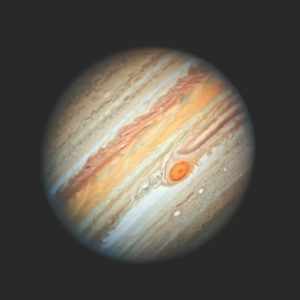
The constellations of summer are passing from the night sky, while our old wintertime friends, like Orion the Hunter, are making their way onto the stage. The planets Jupiter and Saturn are still visible in the early evening, but not for much longer. They’re setting earlier each night, and will soon be lost in the Sun’s glare. When they reappear in January and February 2020, they’ll be in the early morning sky before sunrise.
Why is that? The motion of the planets in the sky is complex, and the explanation for it eluded astronomers from ancient times until about 400 years ago, when Galileo and a few other luminaries settled the matter through careful observation. A full description of celestial mechanics is beyond the scope of this column (and, sadly, perhaps the columnist) but let’s try to tackle the basics.
The planets of the solar system orbit the Sun at different speeds. The farther a planet is from the Sun, the slower it orbits, and the longer it takes to complete that orbit. Earth is much closer to the Sun than Jupiter and Saturn, and completes one orbit for every 12 of Jupiter’s and every 29 of Saturn’s. One orbit equals one year, so a year on Jupiter spans 12 Earth-years, and on Saturn, 29 Earth-years.
Thus, over the course of our year, we approach Jupiter and Saturn in our collective race around the Sun like a runner on the inside lane of a racetrack. Opposition is the astronomical term for when we catch up with them. Then we pass them and pull ahead in our faster inner lane. The race continues as we swing around the Sun opposite them (called conjunction), and they vanish completely from our view for several weeks. Then we emerge from conjunction, and the pattern repeats. As these movements occur, the time of Jupiter’s and Saturn’s rising and setting in our sky shifts.
For now, Jupiter and Saturn are still easy to view at night, so let’s see what we can see. You’ll find them low in the southwest after sunset (see my last column, “Celestial Navigation,” published Aug. 23, though they’ll now be lower in the sky than described there).
To the naked eye, Jupiter looks like a bright gold-white star. Through binoculars, you’ll see Jupiter as a bright disk, with up to four little stars very close to it, in a line together or on either side of the giant planet. These are the Galilean moons (named after Galileo, who first observed them); they are the four largest of Jupiter’s 79 moons. If you watch for long enough, as Galileo did, you’ll see them move over the course of a couple of hours. Some might disappear behind Jupiter, while others may appear over its edge.
Through a telescope you’ll see distinctive bands of dark clouds across Jupiter. If you’re lucky, you might see the Great Red Spot, a giant storm larger than the Earth that has been raging for centuries. It will appear as a dark swirl extending from one of the cloud bands.
On to Saturn. To the eye, it looks like a moderately bright gold star. Binoculars enhance the color, but to see its rings you’ll need a telescope. Yes, you really can see the rings. It’s a spectacular and unforgettable sight. You might also see Titan, its largest moon, as a small dim star close to Saturn.
I mentioned summer and winter constellations in the opening of this column. Next time, we’ll talk about this phenomenon of seasonal stars and constellations, which is similar to the progression of the planets in the sky that you just learned about. Clear skies!



